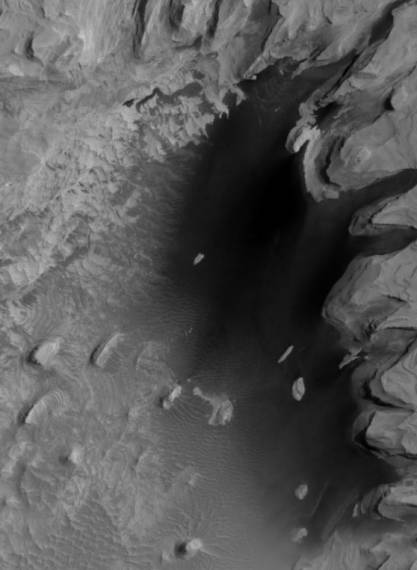
|
A team of researchers from the University of Arkansas has measured water evaporation rates under Mars-like conditions, and their findings favor the presence of surface water on the planet. Water on the planet's surface makes the existence of past or present life on Mars a little more likely, according to the group.
At the 2003 meeting of the Division of Planetary Sciences of the AAS, Derek Sears, director of the Arkansas-Oklahoma Center for Space and Planetary Sciences, and his colleagues graduate student Shauntae Moore and technician Mikhail Kareev reported that they have measured water evaporation rates under simulated Mars-like pressure, atmosphere, sunlight and soil conditions. They wanted to check if water can persist in liquid form under such conditions, and study the evaporation rate.
Sears explained: "Physicists have long argued that Mars is currently a sterile desert, completely unsuited to life. This conclusion is based on their belief that water would evaporate very quickly, as soon as it appeared on the surface."
His team examined the ways in which water-ice behaves when frozen at depth and how it reacts when covered with layers of frost or dust. They also explore how ice behaves when exposed on the surface, and whether it can exist in a transient liquid phase that could harbor life. They determined the fate of the water; whether it remains as ice, becomes liquid, and if so how long it remains as a liquid, or how quickly it evaporates.
And after his study, he concluded that his findings "suggest that even under worst case scenarios, where wind is maximizing evaporation, evaporation rates on Mars are quite low." This implies that surface water could indeed exist, or have existed recently, under the given conditions on Mars.
And this implies that the result of the LR experiment and other experiments by the Viking landers in 1977 which indicated that life thrives on Mars were dismissed on grounds that are not valid anymore.
DPS Pasadena Meeting 2000, 23-27 October 2000
Session 62. Mars Surface and Satellites II
Oral, Chairs: A. Zent, J. Bell, Friday, 2000/10/27, 3:20-4:50pm, C106
R.C. Quinn (SETI Institute), A.P. Zent, C.P. McKay, R.M. Haberle (NASA Ames)
Viking Lander images revealed the existence of water ice (frost) on the Martian surface for extended periods of time during the Martian winter at the VL2 landing site. At the VL2 landing site, and most other locations on Mars, it is expected that water-frost films would completely sublime before liquefaction could occur. While this maybe true for liquefaction of the bulk ice, this process does not necessarily preclude the formation of thin liquid water films at the ice-soil interface in all cases. The formation of such films, even if transient, could play a major role in chemical evolution and weathering on Mars. We present experimentally determined conductance measurements of sublimative loss rates for water ice under Mars-like conditions in the temperature and pressure regimes where thin liquid films exist at the ice-soil interface. A general circulation model is then used to determine the duration and locations where these liquid water films can exist on Mars.